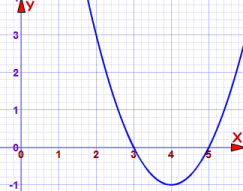Use The Zero Product Property
Naught Product Property
The "Zero Production Property" says that:
If a × b = 0 and then a = 0 or b = 0
(or both a=0 and b=0)
Information technology tin aid us solve equations:
Example: Solve (10−v)(x−three) = 0
The "Aught Product Property" says:
If(x−five)(ten−3) = 0 and then (x−5) = 0 or (x−3) = 0
At present nosotros just solve each of those:
For (ten−v) = 0 we get 10 = 5
For (x−3) = 0 we become ten = 3
And the solutions are:
x = 5, or x = 3
Hither information technology is on a graph:

y=0 when ten=3 or x=5
Standard Form of an Equation
Sometimes nosotros tin can solve an equation past putting it into Standard Class and and then using the Zero Product Property:
The "Standard Course" of an equation is:
(some expression) = 0
In other words, "= 0" is on the right, and everything else is on the left.
Example: Put x2 = 7 into Standard Form
Answer:
x2 − 7 = 0
Standard Form and the Zero Product Property
So allow's try it out:
Example: Solve 5(x+3) = 5x(ten+3)
It is tempting to dissever by (10+3), only that is dividing by zero when ten = −iii
So instead we can use "Standard Class":
v(ten+iii) − 5x(x+iii) = 0
Which can exist simplified to:
(five−5x)(x+3) = 0
five(1−x)(ten+3) = 0
And then the "Zero Product Property" says:
(1−x) = 0, or (x+3) = 0
And the solutions are:
x = 1, or x = −3
And another example:
Example: Solve xthree = 25x
It is tempting to divide by ten, only that is dividing by zero when x = 0
Then allow's use Standard Form and the Zero Product Property.
Bring all to the left mitt side:
xiii − 25x = 0
Factor out x:
x(x2 − 25) = 0
tentwo − 25 is a departure of squares, and tin be factored into (x − 5)(10 + v):
x(10 − 5)(x + 5) = 0
At present nosotros tin see three possible ways it could terminate up every bit zero:
x = 0, or x = five, or x = −v
Use The Zero Product Property,
Source: https://www.mathsisfun.com/algebra/zero-product-property.html
Posted by: schottgromentiout.blogspot.com


0 Response to "Use The Zero Product Property"
Post a Comment